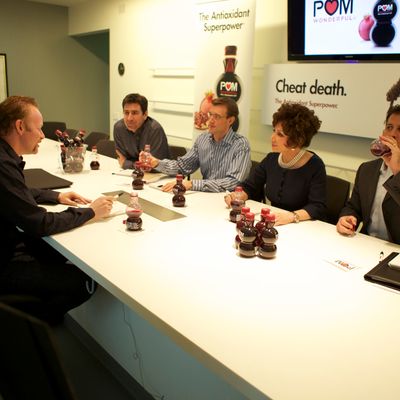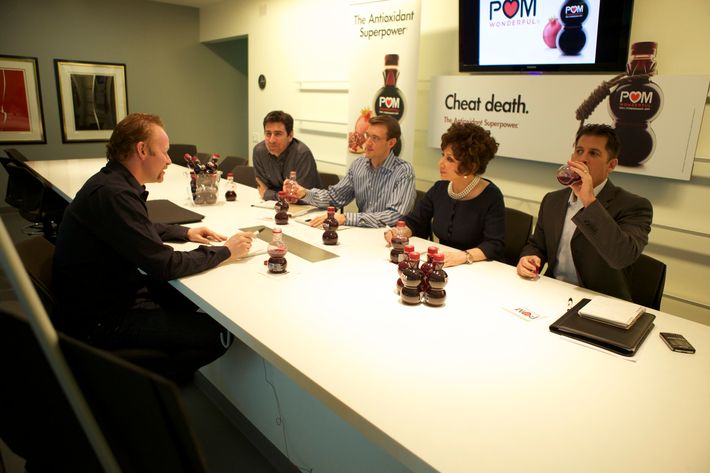

If you fly JetBlue these days, Morgan Spurlock will greet you from your individual seatback TV, welcoming you to the Greatest Airline You’ll Ever Fly. If you stop to get gas and a snack at Sheetz (a chain in West Virginia, Pennsylvania, New Jersey, North Carolina, Maryland, Ohio, and Kentucky), you’ll get a collector’s mug with the director’s mug (heh) on it. If you go to a Hyatt, your room key will bear his image, as will the welcome video to the Greatest Hotel You’ll Ever Experience. You may even see the man himself traipsing around the lobby in a Hyatt-branded robe. He’s staying at the Hyatt as he flies JetBlue, often drinking POM Wonderful 100% Pomegranate Juice out of a Sheetz mug, while promoting POM Wonderful Presents: The Greatest Movie Ever Sold, the latest in his series of funny, megalomaniacal, Jackass-y documentary think pieces (Super Size Me, Where in the World Is Osama Bin Laden, FX’s 30 Days), this time about the prevalence of product placement in our lives.
To drive the conversation and create what Spurlock calls a “doc-buster,” Spurlock has been selling any and all rights to the movie. At The Greatest Movie’s world premiere in January at the Sundance Film Festival (it opens in New York and L.A. on April 22), a man stood up during the Q&A and offered Spurlock $20 to name his question “The Greatest Question Ever Asked.” Spurlock accepted, and Zack Reader’s name is now in the credits. Since that screening, the initial seventeen brand partners have been joined by others, including Petland Discounts, where you’ll soon be able to buy the Greatest Goldfish You’ll Ever Own. Spurlock even bought the naming rights to the City of Altoona, Pennsylvania, which will be known as POM Wonderful Presents: The Greatest Movie Ever Sold, Pennsylvania, for 60 days effective April 27.
According to Spurlock, product placement goes back to Thomas Edison, who, after he invented the motion-picture camera, would shoot movies of people on a train with advertisements for his own products on the side of the train. It can also be seen with novels; in 1873, Jules Verne sold naming rights to shipping companies for Around the World in 80 Days. These days, product placement comes not only in the form of blatant paid plugs, such as the one for the Nissan Rogue in an episode of Heroes that inspired The Greatest Movie Ever Sold (see below), but in more subtle forms. Mane n’ Tail, a human-horse crossover shampoo featured in The Greatest Movie, for example, insisted that Spurlock include a disclaimer stating that they hadn’t paid for product placement. But they still gave him enough product to make the bits featuring Mane n’ Tail possible. Apple, too, famously never pays for product placement — they’ve so successfully positioned themselves as the creative person’s brand that any musician or wacky ad exec must work on a Mac rather than a Dell just for character establishment — but that doesn’t mean Sex and the City had to buy a MacBook every time Carrie typed on one contemplatively by her window, or that Modern Family paid for the iPads they used in the episode where Phil is obsessed with getting one. (Though we’re pretty sure 30 Rock paid for their own McFlurries in that one episode.) Brands recognize the value of these passive endorsements, that if Brad Pitt wears Burberry sunglasses in a movie, someone who wants to be like Brad Pitt will see Burberry as an entry point for doing that. Interestingly, while Spurlock couldn’t get any A-list actors to appear in his movie, actors are increasingly asking for a cut of the product placement deals in their contracts.
The way it works, Spurlock explains, is “if there’s a brand that you already know is in a movie and you know it’s going to be a big film, the first thing they will do is call that brand and see if they can (1) get free stuff from them, so they’ll literally just flood the set with the product and (2) see if they’ll also pay to flood the set with product.” And when companies don’t pay to put their product in the movie, they’ll still employ guys whose whole job it is to make sure their product is readily available on set. “So now when the prop master is like, ‘I need some beer on set today,’ he’s got a truck full of Heinekens, and he puts Heinekens on all the tables. Now, Heineken hasn’t paid to be there, but they’ve paid somebody else to make sure it’s there.” For instance, we know that the presence of Beck’s in The Social Network is a factual detail, but was Mark Zuckerberg really working on Sony computers when he created Facebook? Probably not. Yet vintage Sonys are all over that movie. Did Sony pay for that? Who knows? But it probably helped that Columbia Pictures, which is owned by Sony, made the movie. As Spurlock says, “None of this is an accident.”
And now, without further ado, Vulture presents Morgan Spurlock’s Greatest Product Placements Ever Placed. Behold!
5. Heroes
“The whole film [The Greatest Movie] was inspired by the episode of Heroes where Hayden Panettiere comes walking out of school and the father’s like, ‘Honey, your mom and I were really proud of you. I’ve got something for you.’ And he reaches in his pocket, and it cuts to the front of a car and the camera dollies past the Nissan logo and it cuts back to her face as her father’s holding car keys in front of her face, and the camera wraps focus to her and she was like, ‘Oh my God! It’s the Rogue! The Nissan Rogue! I can’t believe it’s the Rogue! Oh my God, it’s the Rogue!’ I was dumbfounded. That really just happened. Like, literally, there was a commercial right in the middle of the show just then. Then, later on in the show, she and her friends are leaving a party, she’s like, ‘Come on, guys, this is lame. To the Rogue!’ And they go to the car. I was so distraught. I loved that show when it first came out. Season one of that show is one of the greatest things I have ever seen in my life. But as it moved on, just more things like that started happening and it just really lost its compass. So the next day I was so blown away by what I’d seen that I came into the office and started talking to [Jeremy Chilnick, Spurlock’s writing partner] about it. And then we start talking about all the terrible product placement we’ve seen in movies and TV shows and everything. And that’s what inspired this movie.”
4. The Island
“I don’t even know how many brands were in that movie — dozens and dozens of brands. Like every other scene there was, like, a close-up of a logo. The premise is that these people are on an island and all they do is exercise and they’re in great shape. And then it turns out the people who are on this island are clones that are kept alive for these people who are sick on the outside so that they can take their organs. I can’t remember if it was a Nike or Reebok that made all the clothes the people on the island wore. [Editor’s Note: As we learn from the above clip, it was Puma and Speedo.] And then when they escaped, they go into a phone booth and use an MSN Web browser. And when Scarlett Johansson sees her other person, she’s in a Calvin Klein perfume ad that was the real Calvin Klein perfume ad that Scarlett Johansson was starring in at the time. It is literally nonstop that movie. When it’s that kind of overt, or the movie’s not really good, it’s really distracting. The only thing more uncomfortable than looking at all the product placement in that movie was watching Scarlett Johansson run. She apparently doesn’t like to run. She’s a very buxom person, which I think is difficult on the running. Watch Megan Fox running and then watch Scarlett Johansson’s running. They are equally as impressive.”
3. Days of Our Lives
“There’s a great one for Cheerio’s, which I love, where two people meet at a restaurant and he’s like, ‘Sorry I’m late, I just had to pick up some of these.’ And she goes, ‘Cheerios? I have these in my own home.’ And he goes, ‘Yeah, doctor says I need to lower my cholesterol, so I’m gonna start with these babies. You know, one bowl, dah dah dah dah.’ But the one that’s even better, like literally the icing on the product-placement cake, the most incredible and unbelievable you’re ever going to watch, is one for Midol. Here’s this girl who goes into a bar and is like, ‘Oh, I can’t believe this day!’ And she goes behind the bar. ‘What is it?’ ‘I just need a minute and I need this.’ And she reaches behind the bar and pulls out a box of Midol and puts it on the bar. ‘Midol?’ ‘Yeah, when things are really hard for me, and I start having those cramps, and I can’t deal with my day, I take one of these babies. I take a Midol.’ And there’s a whole commercial pitched into the show where this one girl tells the other girl why Midol is great for her and why it’d be great for her. And the other girl says, ‘I’m going to have to pick some up.’ And she goes, ‘You should. I have it in my medicine cabinet at home and at work.’ It was spectacular. You’re watching, you’re like, Wow, this was actually aired on TV.”
2. You’ve Got Mail
“The whole movie is a product placement. Every time he goes on his computer: ‘You’ve got mail!’ It’s like this whole AOL world that this guy’s living in. Even the name of the movie is product placement. It’s like calling a movie “The Pepsi Challenge” something. And then she works at a bookstore and the big Barnes & Noble–like bookstore is coming in and it’s going to shut her down. And they needed a Starbucks. Just pull all the clips of: ‘You’ve got mail! You’ve got mail! You’ve got mail!’”
1. Mac and Me
“By far the most terrible, most unbelievable, most offensive thing you are ever going to see in a movie. I think I saw it on HBO, or Cinemax, or Showtime, like, an hour after it opened in theaters. It’s one of those movies that was so good it premiered on a plane. The whole movie was actually paid for by McDonald’s. I can only imagine the meeting that happened where somebody said, ‘You know what, people? E.T. was a huge hit. People love that E.T. Let’s make a movie with an alien. And so the alien comes to Earth but the alien loves McDonald’s. We’re going to do for McDonald’s what E.T. did for Reese’s Pieces.’ It is one of the most terrible movies you’ll ever watch. First off, nobody told them you actually need a good script to make a good movie. Second, you can’t have an entire movie where the alien looks awful. Like, pour some of the money that you put into those terrible dance sequences and make a decent-looking character for your movie instead of that rubber sock puppet that they turned into the alien. And three, literally, in the middle of this movie, dance sequences break out in the middle of McDonald’s and Ronald McDonald is there dancing and the alien is there. It’s the worst thing you’ll ever see in your life. I can’t believe someone ever said in a room, ‘This is a great idea.’”




